Supermarine Spitfire, Figullar, Monaghan September 1942
On the afternoon of Sunday, September 20th 1942, the residents of the townland of Figullar, in County Monaghan, Ireland, were presented with the spectacle of an aircraft crashing in a field while the residents of Crilly, in County Tyrone, Northern Ireland, found its pilot parachuting to safety in their midst.
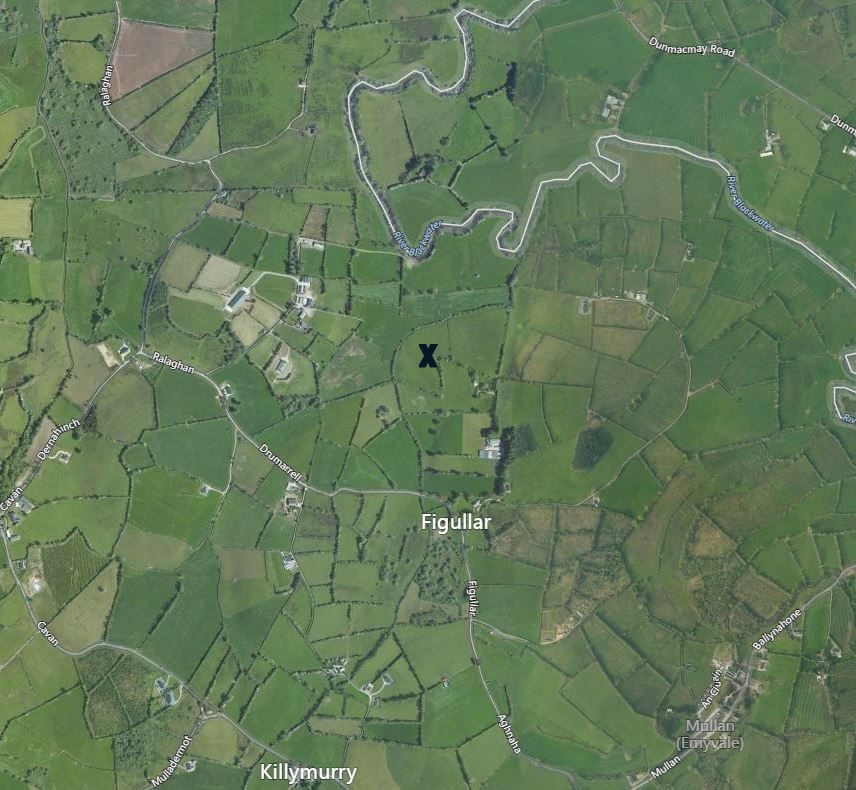 The crash
site, in the townland of Figullar, was quickly attended to by
members of the Local Defence Forces (LDF) and the Gardai, the
Irish Police Service. It seems that despite the
border between the two jurisdictions, communications were not
curtailed and it was soon known that there was no casualty
associated with the incident as the pilot had bailed out over
Northern Ireland and landed near Crilly House, in Tyrone.
Upon landing he was brought to the nearest Royal Ulster
Constabulary (RUC) station and from there arrangements were made
for him to return to his unit. The aircraft crash site,
shown in the image at right from Bing maps, highlights the
location of the crash in a field bordering on the townland of
Ralaghan. Crilly house is to be found off that image to
the North. The white line on the image shows the location
of the border between Ireland and Northern Ireland in this area,
along the River Blackwater.
The crash
site, in the townland of Figullar, was quickly attended to by
members of the Local Defence Forces (LDF) and the Gardai, the
Irish Police Service. It seems that despite the
border between the two jurisdictions, communications were not
curtailed and it was soon known that there was no casualty
associated with the incident as the pilot had bailed out over
Northern Ireland and landed near Crilly House, in Tyrone.
Upon landing he was brought to the nearest Royal Ulster
Constabulary (RUC) station and from there arrangements were made
for him to return to his unit. The aircraft crash site,
shown in the image at right from Bing maps, highlights the
location of the crash in a field bordering on the townland of
Ralaghan. Crilly house is to be found off that image to
the North. The white line on the image shows the location
of the border between Ireland and Northern Ireland in this area,
along the River Blackwater.
The first Irish Army party to arrive on the crash site south of
the border in Figullar was one under the command of 2/Lt Vincent
Kenny of the 11th Cyclist Squadron based at Cavan
Barracks. 2/Lt Kenny submitted a report to the Irish
Army’s Eastern Command two days later which read as follows:
I wish to state that at approx. 13:15 hrs on
the 20/9/42 the command Duty Officer informed me by ‘phone
that an aircraft had crashed at a place about three miles
North East of Emyvale, Co. Monaghan. I was detailed
to take an armed party out to scene of crash. I
arrived at scene, with a party of one N.C.O. and six men
at approx. 15:00 hrs., and found a guard of L.D.F. men,
and Civic Guards from Emyvale and Monaghan town in charge
of the plane. An L.D.F. Staff Officer named J J
McGleoin from Monaghan was in charge of the Guard.
I took over charge and posted sentries around the
‘plane. I found out from J J McGleoin, and a
Detective Officer from Monaghan town, that there had been
no interference with the wreck.
The ‘plane was a Spitfire, of British nationality, and had crashed at approx. 11.20hrs on 20/9/42, in a field of Patrick McKenna, Figualliar (sic), Emyvale, Co. Monaghan. The pilot, the only occupant, had bailed out from the plane at 4,000 feet, and had landed safely in Northern Ireland territory. The scene of the crash is about three hundred and fifty yards inside our territory. The plane just before crashing apparently fell to pieces, as parts of the wings and fuselage were found scattered about, at least three hundred yards from where the nose of the plane struck the ground. When the ‘plane struck the ground, there was an explosion, and she went on fire. One of the first men on the scene was J J McGleoin, L.D.F. Monaghan Staff, and he got some help and tried to extinguish fire, but was unable to do so, as a result of the crash and fire there were four “hand” cocks of hay, (approx. ten cwt. Of hay in each) belonging to J J McKenna, Figulliar, Emyvale, destroyed.
I then went into Emyvale Gardai Station and reported to the Command Duty Officer, and was informed by him that permission had been granted by the Dept. to two R.A.F. officers to search 'plane for a high explosive detonator. Their names, car Reg No.etc. were given me. I was given instructions that those Officers were not to take anything away with them. I went back to the Plane, and at about 16.15 hrs. four R.A.F. officers and two R.U.C. Sergeants in uniform arrived in the field. They asked to examine plane but I refused, pointing out that two of their technicians were due to arrive any minute,- when they heard that they departed immediately. At approx. 17.30 hours those two Officers arrived dressed in civilian attire and in possession of their credentials, they examined the ‘plane thoroughly and told me that the Detonator could not possibly escape exploding after crash and fire, and that there was no danger in handling it. They remained for about half an hour, and did not take anything with them on leaving.
The plane was only a twisted mass of wreckage
with parts of wings and fuselage scattered about. I got
those parts collected into a heap, and again got in touch
with the Command Duty Officer, I explained the situation
to him, and he informed me that if the L.D.F. would do
guard on the plane for the night, we could withdraw.
District Officer(L.D.F.) McGleoin volunteered to have
guard on the ‘plane. I collected the loose aluminium and
tin (about Three Cwts.) and put it into truck and brought
it back with armed party to Cavan Barracks.
I left L.D.F. Officer J.J. McGleoin in charge of the
‘plane.
I got in touch next morning with your office
and acted on your further instructions.
Signed Vincent Kenny 2Lt
11th Cyclist Squadron
In the days after the crash, the wreckage of the aircraft was
gathered as best it could and transported to Clones army
barracks. It languished there for a few weeks and the last
mention of the wreckage in the Army report is a file on the
weight of metal as it was likely to be sold for scrap.
Due to some unfortunate issues with RAF records, determining
the pilot of Spitfire R6992 on September 20, 1942 was for a long
time based on a little assumption.
The usual primary source to determine pilot names, the unit
Operations Record Book (ORB) for 1402 Met. Flight, for the day
of the crash refers to the pilot only as F/L
Proctor. Reasercher, Martin Gleeson of
Limerick, shared his detailed review of the ORB only to find
that during the entire period of his posting he was referred to
only by rank and surname.
The ORB for 1402 Flt. (AIR 29/866) "mentions
him almost daily from December 1941 to January 1943 (14
months !) but not once is he recorded as anything but "F/Lt.
Proctor" ! In January 1943 he was posted to the A
& AEE at Boscombe Down. In their ORB (AIR 29/896)
he is only mentioned twice". Martin
also reviewed the London Gazette and RAF Lists to compare other
officers named Proctor against the promotions and awards listed
in the ORB. This review revealed the following events and
time line:
- 4-Dec-1941 Pilot Officer Proctor
posted in to the Flight.
- c.15-3-1942 P/O Proctor promoted to the rank of
Flying Officer.
- - -London Gazette 35467, dated 24th February 1942, published
the following promotion:
- - - - Plt. Offs. (prob.) confrnd. in appts. and to be Flg.
Offs. : —
- - - - G. H. PROCTOR (60769). 15th Feb. 1942. (Seny. 14th Jan.
1942.)
- 1-5-1942 F/O Proctor promoted to the
rank of Acting Flight Lieutenant.
- 20-1-1943 F/L Proctor posted to the Aeroplane and Armament
Experimental Establishment (AAEE).
- 7-6-1943 F/L Proctor Mentioned in Dispatches for his work
on this Flight.
In the records for the A & AEE he is recorded in two
postings.
- 23-1-1943 "F/Lt. G.A. (sic) Proctor
posted to A & AEE from No. 1402 Flight (Flying duties
with High Altitude Flight)."
- 23-7-1943 "F/Lt. G.H. Proctor posted to No. 12 (P)
AFU."
This latter unit, 12 (P) AFU, or to give it its full title, 12
(Pilot) Advanced Flying Unit, was based at RAF Spittlegate near
Grantham, and it would have likely seen Gordon flying twin
engine aircraft like the Oxford in preparation for posting to an
operational unit.
In may of 2012, a fond wartime friend of Gordon's, Margaret,
found a newspaper request of mine seeking details of Gordon
Proctor. She very kindly sent the following cartoon sketch
that was among his belongings sent to her after his death.
A copy of this was also provided by his nieces in 2018.
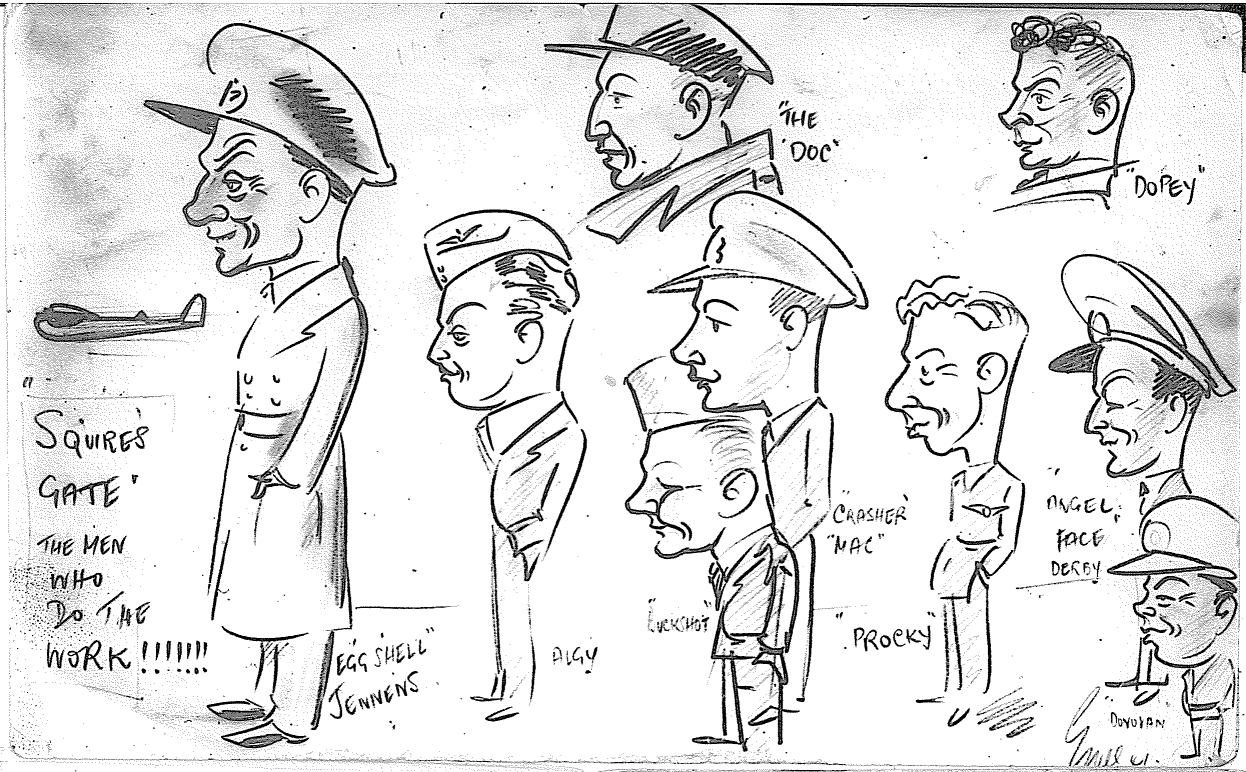
This mentions him being at Squires Gate and is titled, "The men
who do the work". Most of the caricatures cannot be
identified as no surnames are given other than the possible "Egg
Shell" Jennens. The only RAF officer at that time with
this surname was Lionel William Vaughan Jennens, a prewar RAF
officer who had served from 1930 to 1937 before entering service
with Imperial Airways. As a reserve air force officer he
returned to the Air Force upon the break out of war. His
family, in their records of L W V Jennens career, noted that he
was the commanding officer of the School of General
Reconnaissance prior to his posting to 7 Squadron where he was
shot down in December 1941, spending the remainder of the war as
a high ranking prisoner of war. This suggested, prior to
2018 and the information provided by his neices, that Gordon
Procter was even before his posting to 1402 Flight, an
experienced pilot. At least 12 aircrew with serial numbers
starting with 7417xx had been lost in the 1939-1940 period of
the war.
Using this information, along with the search of the London Gazette and the Royal Air Force Lists, by Martin Gleeson and other members of the RAF Commands internet forum, it seemed most likely that F/Lt Proctor was F/Lt Gordon Hayter Proctor, serial number 60769.
The second primary source one might rely on is the Air Ministry
Form 1180, aircraft loss card held publicly by the RAF Museum in
Hendon, however that card is not among the cards held in their
microfilm archive, this would have firmly recorded the pilots
name by surname, initials and service number. The AIR81
series RAF casualty files does not contain a file for the crash
either, presumably since the pilot was not injured or
missing.
A further source of confirmation was tried with the Irvine
Parachute Company, who awarded a lapel pin to airmen who wrote
to confirm they had been saved by one of the companies
parachutes, the person them becoming a member of the Caterpillar
Club. Unfortunately, the Club membership was based on the
understanding that the company would never divulge information
about recipients. The modern day company however did
appear to confirm that the name of the Gordon Hayter Proctor was
on their membership lists for this date. His nieces were
however able to provide am image of his Caterpillar Club card.
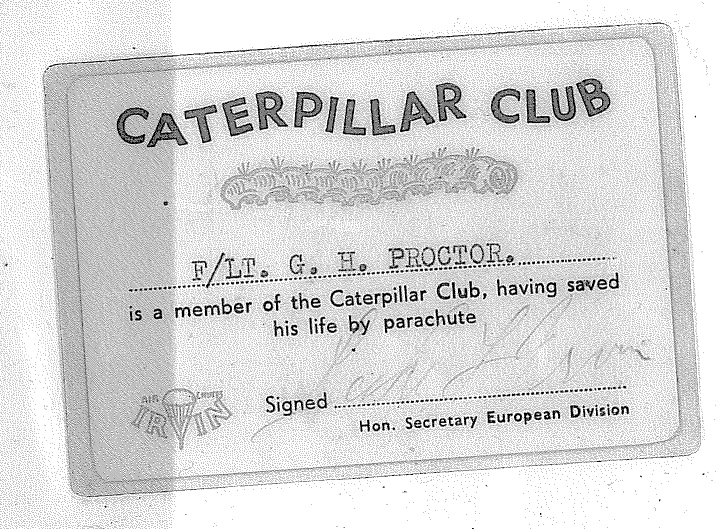
Finally in early 2018, one of Gordon's nieces, having seen the
Dunkirk movie, decided to search up on him, and found mention of
the excavation of the aircraft and was able to make contact with
me. Gordon's very generous three nieces were able to
reveal his wartime flying log books. They provided
confirmation of his being the pilot of R6992 and his record of
his days flaying.
His days flying began with a attempt at a Met Climb in Spitfire
R6992, but the flight had to be abandoned after a few minutes
when he discovered the VHF radio was unserviceable (U/S).
He returned to based after 20 minutes flying. This was
clearly fixed because he took off again in R6992 and flew for 1
hour and 20 minutes before having to bail out due to his cockpit
instruments having gone unserviceable. In his log book he
recorded:
INSTRUMENTS U/S; CLIMBED 36,000'. CLOUD
10/10
18,000 - 200'; BALED OUT 16,000', LANDED SAFELY
AIRCRAFT CRASHED AND COMPLETELY DESTROYED
IN EIRE. COURT OF ENQUIRY BEING HELD.
 |
 |
it is interesting to note that he did undertake another
flight later in the same day as the bail out, this time in
Gladiator K5576
 Gordon Hayter Proctor
was born in Streatham, on the 7th December 1914. His
parents were Frank Bloomfield Proctor and Fanny Eliza
Reed. The couple had married in Clapham in 1903, and had
two children before Gordon was born, Stanley in 1904 and Vera in
1912.
Gordon Hayter Proctor
was born in Streatham, on the 7th December 1914. His
parents were Frank Bloomfield Proctor and Fanny Eliza
Reed. The couple had married in Clapham in 1903, and had
two children before Gordon was born, Stanley in 1904 and Vera in
1912.
Frank Bloomfield Proctor had served from 1916 to 1918 with the
137th Heavy Battery of the Royal Garrison Artillery. He
would likely therefore have served at many of the large battles
of 1916 - 1918 on the western front.
In the 1938 Electoral Register, Gordon can be found listed
living with his parents at 94 Ellison Road, Streatham. The
following year, the parents had moved to 13 Sunmead Close,
Fetcham. Gordon was at that time living at 32 Bradford
Drive with a family named Gale. In the 1939 Register, he
is listed living at home with his parents and having the
occupation of Bank Clerk. He is noted as being an RAF
Reservist however.
His father Frank died in Mount Alvernia Nursing Home on 5th
February 1958, with his address given as Lilyville, 13 Sunmead
Close, Fetchem, Surrey. Fanny Proctor passed away in
Hoylake on 17 Apr 1963.
Gordon's log book and service files reveal he had an eventful
war, flying mainly in second line roles up until his posting to
45 Squadron.
His service history included:
19 E&RFTS,
Gatwick
9/Jul/38 to 3/Sep/39
15 Flying Training School (FTS), Lossiemouth and Middle
Wallop
1/Jan/40 to 19/Jun/40
He was awarded his pilots badge following completion of training
at 15 FTS, 10 Jun 1940
1 Operational Training Unit (OTU),
Silloth
27/Jun/40 to 22/Feb/41
3 School of General Reconnaissance, Squires
Gate
22/Feb/41 to 4/Dec/41
Attached No. 1 Beam Approach Course (BAC),
Watchfield 6/Jul/41 to 18/Jul/41
1402 Met Flt, Aldergrove
5/Dec/41 to 23/Jan/43
During his time with 1402 Flight he was the victim of a number
of incidents with Gladiators, Spitfires and Blenheims, including
forced landings and losses of instruments. Notwithstanding
this, he finished up his time at 1402 Flight having flown at
least 485 'Met Climbs" in the year.
A&AEE, Boscombe
Down
23/Jan/43 to 23/Jul/43
His name was published in the London Gazette having been awarded
a Mention in Despatches dated 23 Jun 1943.
No 12 (P) AFU, Grantham
23/Jul/43
1536 BAT, Grantham (Beam Approach Training
Flight)
8/Sep/43 to13/Sep/43
60 OTU, High Ercall
28/Sep/43
Lyneham and 301 Ferry Training Unit, 14/Jan/1944.
During this early 1944 posting to RAF Lyneham, he delivered a
number of Mosquito aircraft from the UK to North Africa and it
is assumed this brought him to Cairo where he was pictured at
the Pyramids. The names of the other airmen, another pilot
and two navigators were not recorded on the photo. Gordon
is the man standing in the middle of the group.
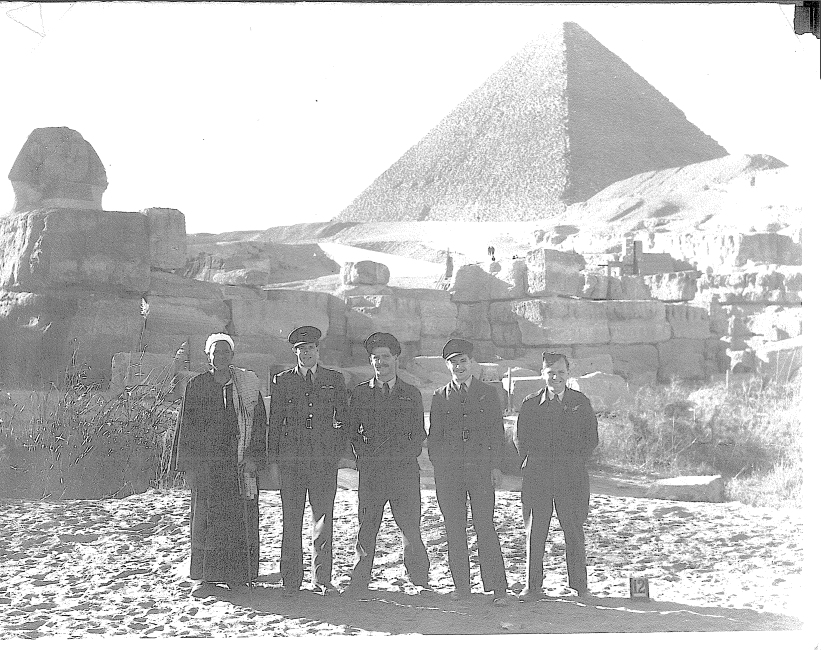
HQ, Air Command South East Asia
Command
12/Mar/44
308 Maintenance Unit and 21 Ferry Control
18/Mar/44
45 Squadron
14/Aug/44
Gordon Proctors luck in 1942 did not last sadly. His time flying in second line duty was at an end and he was posted to his first war time front line unit.
The operations record book for 45 Squadron at Ranchi in India
on September 3, 1944 reads:
“Stand down was
observed today. F/Lt G H Proctor posted to the Squadron,
arrived with his navigator Sgt G Bargh. The football
team played an exciting match against a ‘hot’ Army team, the
result after a hard tussle being a no score draw.”
The Squadron was at this time not on operations having converted onto the Mosquito twin engine fighter bomber. Gordon's last recorded flight in his second log book is dated 22 September from Kumbhirgram in a Mosquito.
At 14:36 on the afternoon of 3rd Oct 1944, F/Lt Proctor
departed from Kumbhirgram in Assam in Mosquito HP936 with his
navigator, F/Sgt George William Bargh from Church Warsop,
Nottinghamshire. This was the first and only operational
mission that their names are found on in 45 Squadron, the unit
having only commenced operations on October 1st and the
Proctor/Bargh crew were not involved in those first two days of
attacks. This mission was lead by F/O A N Houn and F/O H J
S Cargill 406193 of the Royal Australian Air Force in Mosquito
HP978.
The narrative for the missions reads as follows:
“Offensive recce
MEKTILA and KANGDAUNG* A/Fs. IRRAWADDY crossed at
PP.2075 and course set for target. Target not seen,
cloud 10/10ths. A/F most probably THABUTKON covered
deck level 16.18 hours. Definitealy (sic) no A/C in
Northern dispersals, nothing believed in others. No
movement seen, Pens appeared overgrown. Steam roller
southern end, steam up. Railway pin pointed YWAPALE
LL.5237 (station name seen) course set for target area again
but heavy rail (sic) encountered and nothing seen except
possible 1 A7C Pen.
As aircraft HP.936 had been airborne 30 minutes before the
leader, course was set for base. This A/C was last
seen at position PP.8030 16.39 hours on Course 300˚, 50
feet, and is still missing. No attacks were made,
bombs and ammunition were brought back.
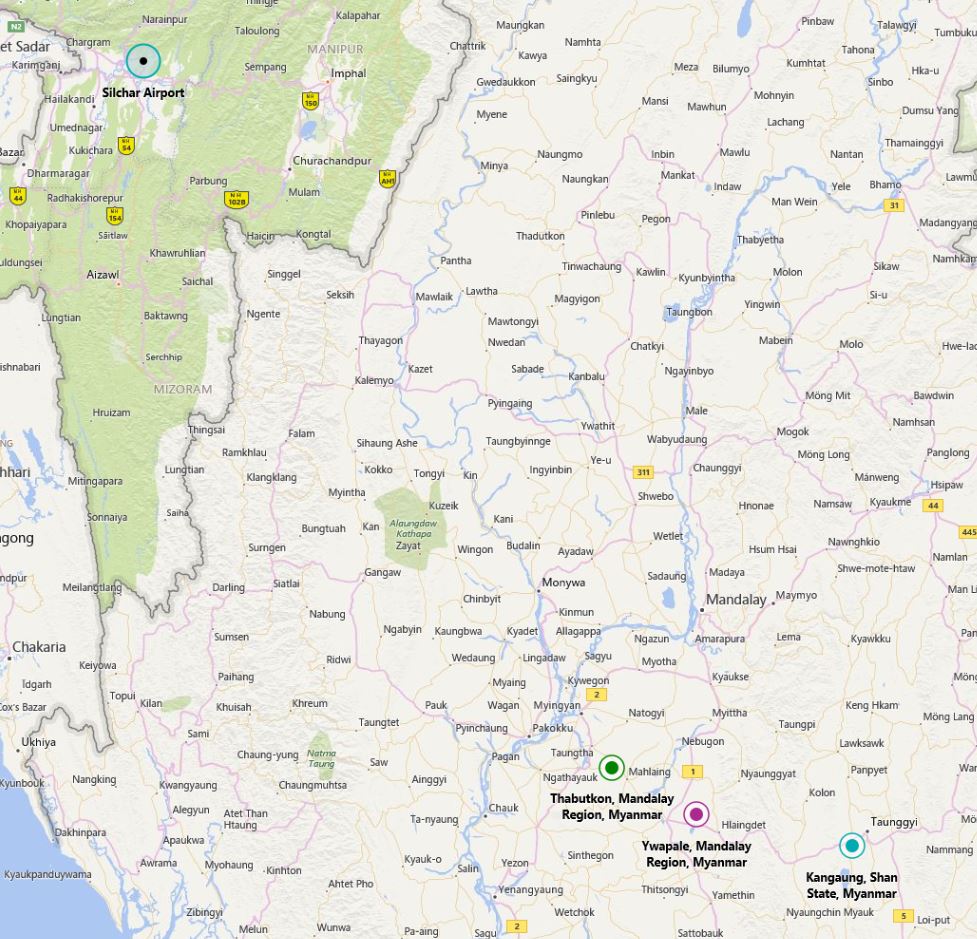
Kumbhirgram air field is the site of the modern day Silchar
airport in Assam. The target airfield of Kangduang may be
a spelling error in the report and be referring to Kanguang, to
the east of Meiktila town. The route back to their
airfield would have brought them back across the inhospitable
peaks of the Arakan (or Rakhine) Mountains, and not forgetting
the long trip back across the plains of Burma which at that time
were still occupied by Japanese forces.
The names of both F/Lt Proctor and F/Sgt Bargh are today
remembered on the Singapore Memorial.
In May 2017, a joint group from Queens University Belfast and Monaghan County Museum
accompanied by researcher Jonny McNee carried out a licensed and
approved dig on the site and in the process recovered some
remains of the Spitfire, including a corroded cockpit door and a
section of engine crankcase with attached pistons. The
recovered parts are displayed at the County Museum from 2018
following their cleaning and conservation.
This exhibition opened in June 2018 and information about it
can be found here on the Museum website. Click on the
image to read more.
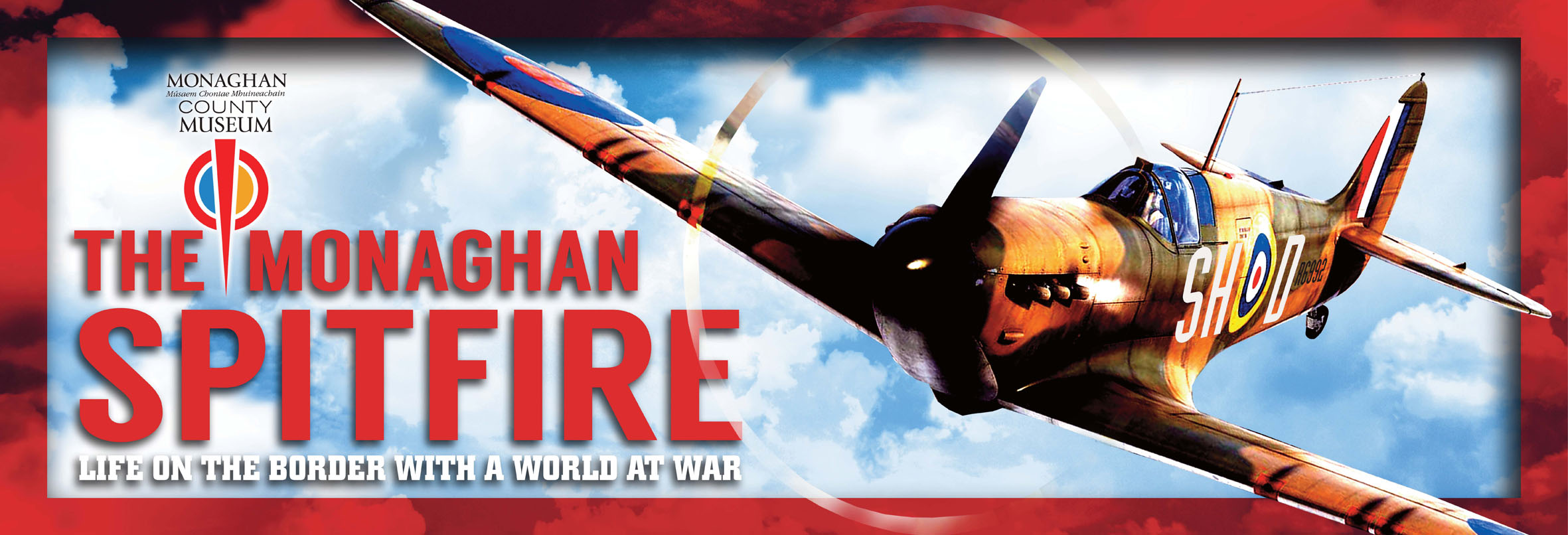
The page also links out to a PDF file created at the start of
the exhibition based on Monaghan and the Second World War.
Compiled by Dennis Burke, 2024, Dublin and Sligo. Information Sourced from the Irish Military Archives, Martin Gleeson, ancestry.com, RAF Commands message forum, Jonny McNee and M Watson correspondence and the wonderful assistance of G H Proctors three neices.
